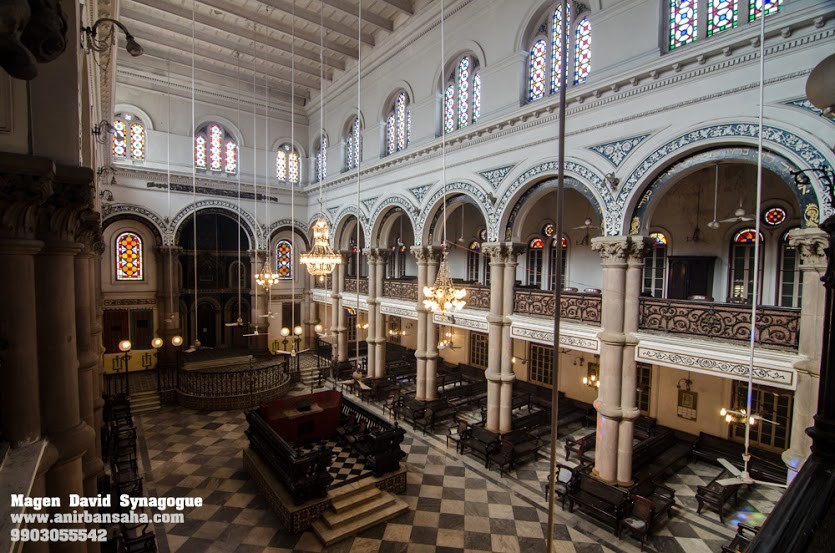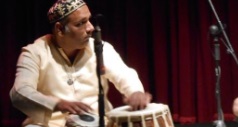MAGEN DAVID SYNAGOGUE (1884)
109A, Biplabi Rash Berhari (formerly Canning Street) at Brabourne Road
(with Old China Bazar and Indra Kumar Karnani Streets running to rear sides of the property)
Kolkata (formerly Calcutta)
West Bengal, INDIA
This grand synagogue, albeit still fitted and maintained, is no longer a fully-functioning house of prayer due to the diminished local Jewish population, and the building is now under the custodianship of the governmental Archeological Survey of India (ASI). Long-standing and dedicated synagogues custodians are regularly on duty to receive guests during the week at regular hours, so a visit should be straightforward and easy. There is no telephone number for this site, however native Jew (yet not always in Kolkata)Jael Silliman at This email address is being protected from spambots. You need JavaScript enabled to view it. can be contacted for information.
One of India’s grandest synagogues, and designated by sources as among the largest in Asia, Magen David (Hebrew for Shield of David) has for more than a century-and-a quarter been a landmark work of architecture in Kolkata. The last of the city’s main synagogues to be realized, it was dedicated on the 11th of September 1884 when the Baghdadi Jewish community was thriving. Located at Biplabi Rash Berhari Road (formerly Canning Street) and Brabourne Road (with Old China Bazar and Indra Kumar Karnani Streets running to the rear sides of the property), this prominent site in central Kolkata had been the site of Neveh Shalome (Hebrew for Oasis of Peace) Prayer Hall, a Baghdadi Jewish house of prayer, until it was demolished in 1883 (and later rebuilt in 1911 as a larger synagogue next door). The synagogue was made possible through the generous donation of a Kolkata Baghdadi Jew, Elias David Joseph Ezra in memory of his father, David Joseph. Ezra had settled in Kolkata from Baghdad and amassed his fortune in business and real estate. He began a tradition of family service and philanthropy with the construction of Beth El Synagogue in 1856 and other local buildings, and this practice was carried on by his son, Elias David Joseph.
Magen David was designed by a British colonial architect based in India who was well versed in English and other European building traditions. The imposing flat-roofed synagogue, measuring 25 meters by 43 meters (82 feet by 140 feet) and set behind a wall and gate along the busy street, is stylistically a Renaissance-revival structure. Finished in rust-colored brick with buff stone accents, the synagogue’s most commanding feature is its corner tower that soars to a height of 43 meters (140 feet). The tower displays an English-manufactured clock with faces on four sides that originally chimed every quarter hour, and it is capped by a steeply-pitched slate-tiled roof crowned by a finial. Along the sides of the synagogues are repetitive bays of rounded-arched windows, decorated panels, and bands of trim that faithfully follow the Italian Renaissance-revival aesthetic. Ultimately the Magen David congregation, as did the other Baghdadi communities, chose a sort of architecture devised in Europe and revived in the nineteenth century as a precedent for their house of prayer. When seeing this synagogue and other Baghdadi ones in India for the first time, foreigners and nationals alike may be surprised by what they can regard as buildings appearing un-Indian and sometimes Christian. Yet in the British colonial landscape, these imposing, Western-style structures were in keeping with tastes of the British and those that regarded themselves as loyal subjects of the British crown. Considering that synagogues as an architectural genre have rarely established a specific design aesthetic anywhere in the world, the borrowing of various other design inspirations at Magen David represented a common practice.
Magen David’s congregation was established in Kolkata among Baghdadi Jews who had immigrated to the city during the early-to-middle years of the nineteenth century. The first Baghdadi Jews to come to India did so seasonally or on a temporary basis in the late eighteenth century, arriving first in the western port city of Surat. In time, a permanent enclave was formed in Kolkata with others in Mumbai, Pune, and Yangon (Rangoon), Myanmar (Burma). Jews mostly from Iraq, but also from Iran and various Ottoman Empire lands left their homelands in search of religious tolerance, safe haven, quality of life, and opportunity. The community as a whole became comparatively well-educated and economically comfortable in their adopted Indian and Burmese cities. Pune came to offer the Baghdadis affiliated with this synagogue the chance to become fully practicing Jews and productive citizens of the broader local community.
A porch leads to an anteroom that is flanked by an office to one end and the stairway up to the gallery at the other side. Lining the walls of this anteroom is a number of inscription and donation plaques installed over the years. Pairs of doors at the long side of the anteroom open into the sanctuary. It is an impressively large space able to accommodate a membership that, at its height, numbered over one hundred families. In plan, the generous triple-height central nave with its tebah (bimah, or raise reader’s platform from where the Torah is recited and the prayer service is led) is separated from the two double-height side aisles by a colonnade of compound, or bundled limestone columns with carved floriated capitals. Sources indicate that these columns were quarried and fabricated in France and sent to Kolkata for installation. Clerestories with stained glass, gray and white marble floor tiles set in a checkered pattern, and the raised tebah with brass balusters are prominent design features. Filling the sanctuary, in Baghdadi and other Indian synagogue fashion, are several freestanding long wooden benches and chairs as well as various-styled hung lighting fixtures (some originally gas-lit and featuring Belgian glass) and ceiling fans. Panels throughout the sanctuary that run along the curved arches, in between the columns, and on wall surfaces are highly decorated with floral patterns and Hebrew inscriptions. As per Orthodox synagogue custom, the ground floor is where men sit, whereas the gallery level is the women’s seating area.
Magen David follows the pattern of other Baghdadi synagogues in India and Myanmar in that it contains a particularly prominent architectural and liturgical feature: a sizeable heckal (ark). The heckal, positioned on the wall nearest to Jerusalem as per synagogue convention, is set within a high half-domed apse. Its ceiling is painted a deep blue with gold stars to represent heaven. From within the sanctuary, the heckal curtain (the fabric common in many synagogues) and doors appear to front a conventional, cabinet-like space. Yet once they are opened, a walk-in apsidal-shaped room as deep as three meters (ten feet) and considerably wider is revealed. Here one hundred or more Torah scrolls set within decorated cases were proudly displayed. Today, as is the case with its much-diminished membership, a far lesser number of Torah scrolls remain at Magen David. Most of them have been shared with communities in Israel and elsewhere.
Over the years, various anniversary celebrations attended by congregants and invited guests have been held at Magen David, some marked by commemorative publications. As a result of political and social changes in India that started in the 1950s, India’s Baghdadi Jewish community decreased precipitously, and with that came the decline of synagogue life in Kolkata. Magen David, a protected building by the Architectural Survey of India and carefully restored by the ASI at the turn of this century, remains open and can be visited, yet today it struggles to function as a synagogue due to the shrinkage of its membership. At the time this plaque was prepared, the Baghdadi Jewish population of Kolkata was estimated to number only around twenty people. Regular prayer services may not be held here, but holiday services are, and on Friday evenings a lamp is lit inside the sanctuary by a resident Jew to welcome in the Sabbath. Magen David continues to be lovingly watched over by dedicated caretakers who, like the Baghdadi Jews left here, recognize the building (set within a fairly generous and peaceful compound) as an important religious and civic monument that has been a part of the history and fabric of the Kolkata for so many years.

Exterior

Interior








